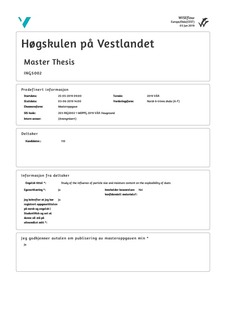| dc.description.abstract | This project was started on the behest of the NFPA Research Foundation. It consists of a literature review and a statistical analysis. The aim has been to uncover whether the median particle size limit given in the standard NFPA 664 is supported by scientific literature. The standard applies to woodworking industries and considers dust with a mass median particle size greater than 500 μm and moisture content above 25% to be nondeflagrable.
The literature review focuses on finding the effect of particle size and particle size distribution as well as moisture content. In addition, since shape is a defining attribute of biomass dusts, particle shape has also been studied. A major point in scientific literature is that smaller particles are considered more dangerous because they are more easily ignited, more easily dispersed and will give more violent explosions. Larger particles require more energy to heat to the point of devolatilization and leading to a decrease in maximum explosion pressure and maximum rate of pressure rise. Explosion severity’s dependence on particle size is considered well-established through explosion tests. Such tests should, according to standards, be executed in a 1 m3 explosion chamber. The explosion chambers are equipped with instruments to measure and record pressure development. There is also a more affordable version of the explosion chamber, the 20 L-sphere. It can be calibrated to match the results from the 1 m3- chamber and is widely used.
As part of the literature review a data collection was also conducted. The original intention was to only collect data from research on wood. This quickly proved a challenge as there were limited amounts of data available. To have enough data to perform an analysis, other biomasses was added to the collection, then coal dust was added as well. The samples were first considered all together, then coal and biomass were considered separately, finally biomass was split in to wood and non-wood biomasses. This enabled comparison between coal and biomass, and between wood and other biomasses. The data has been used to look for correlations between attributes of the dusts (d10, d50, d90, PDI and moisture content) and the explosion properties (Pmax, (dP/dt)max, KSt and MIT). To examine particle size distributions histograms and boxplots were used. Biomass and coal were compared and among the samples, biomass show a wider range of particle sizes. The average biomass particle is also larger than the corresponding coal particle. Despite this Pmax is higher for biomass than coal.
Some findings were in line with the expectations set by the literature review, while other where surprising. Like in cases where the correlation analysis showed opposite trends between coal and biomass. This would suggest that drawing conclusions for biomass based on what is known about coal is not optimal, neither is using standard equipment or procedures developed for coal.
The main conclusion is that there is a great need for further work. There need to be an agreed upon standard for how to measure particle size, especially biomass. In addition, finding out which dust parameters is most useful to predict explosion outcome is urgent. | nb_NO |

